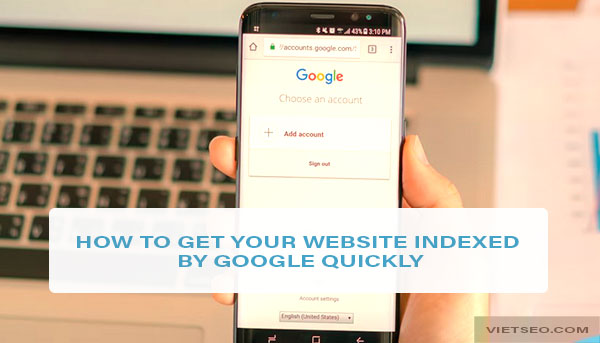How to get your website indexed by Google quickly?
Indexing plays a very important role. It is the first step to a successful SEO strategy, helping to ensure your pages appear above Google search results.
Indexing is just one important step in the chain of steps required for a successful SEO strategy. The entire process can be broken down into about three steps in total:
- Collect data on the Web.
- Indexing.
- Rating.
Did you know that it is possible to get Google to index your site quickly? In this article, we'll share how to get Google to crawl and index your site quickly, faster than your competitors.
What is crawling, indexing, and ranking?
Every page discovered by Google goes through the same process, including crawling, indexing, and ranking. They are steps in Google's process to discover web pages on the World Wide Web, and show them higher in their search results.
First, Google will crawl your Web site to see if it's worth including in its index.
The step after crawling will be called indexing. Assuming that your site passes the first reviews, this will be the step where Google proceeds to assimilate your site into its own classified database index of all available pages, without Google has crawled so far.
And ranking is the final step in the process. This is where Google will display your query results.
Google will do this in less than a millisecond.
Finally, the web browser performs the rendering process so that it can properly render your web page, allowing it to actually be crawled and indexed. And rendering is just as important a process as crawling, indexing, and ranking.
If you're doing a Google search, the only thing you're asking Google to do is provide you with results that contain all the relevant pages from its index. Usually, millions of pages can match what you're looking for, so Google has to have ranking algorithms to help determine which pages to show as the best and most relevant results. for your query itself.
So crawling is preparing for the challenge, indexing is doing the challenge, and in the end, ranking is winning the challenge.
1. Your web site must not only be valuable, but also unique.
If you're having issues with your page's indexing, you need to make sure it's valuable and unique. Sometimes, what you consider valuable may not be the same as what Google considers valuable. Furthermore, Google is also incapable of indexing low-quality pages, as these pages offer no value to its users.
If you've gone through the technical page-level SEO checklist and everything is checked (meaning the page is indexable and doesn't have any quality issues), then you should ask yourself: : Is this site really valuable?
Review your Web site with a fresh pair of eyes, which can help you identify problems with content that you wouldn't normally see. In addition, you may also find things that you didn't realize you were missing before.
Another way to identify these specific types of pages is to perform analytics on pages that are of poor quality and have very little organic traffic in Google Analytics. Then you decide which pages to keep and which to delete.
However, you need to look very carefully if you want to remove pages that have no traffic. Because they can still be valuable pages. If these pages cover the topic and are helping your site become an authority topic, don't rush to delete them.
2. Have a plan to regularly review, update, and re-optimize older content.
Google search results change constantly, and so do the websites in these search results.
Sites in the top 10 results on Google are always updating their content and making changes to their pages on a regular basis. That's why it's important to keep an eye on these changes and spot-check the changing search results, so you know what you need to improve and change on your site next time. according to.
Get regular monthly or quarterly reviews, depending on how big your site is, to stay up to date and ensure that your content stays valuable, unique, and continues to outperform compared to competitors.
If your competitors add new content, find out what they've done further and how you can beat them. If they make changes to their keywords for any reason, then go ahead and find out what those changes are and beat them up.
As such, you must always be willing and committed to publishing regular copies of your content, and updating your old content on a regular basis.
3. Remove low-quality pages and create a schedule to remove content on a regular basis.
Over time, through analysis, you may find that your pages often won't perform as expected. In some cases, these pages only serve as a secondary, and do not enhance the blog in terms of contributing to the overall topic.
These low-quality pages will also often not be fully optimized. Because, they don't align with SEO best practices, and there's no way to optimize them in a good, ideal way.
Here are six elements of every page that should be optimized on a regular basis:
- Page title.
- Meta description.
- Internal links.
- The tags in the article, such as: H1, H2, H3, ...
- Image of the article (alt image, image title, size of the physical image, etc.).
- Markup Schema.org.
However, don't just because a page isn't fully optimized, consider it a low-quality page. See if it contributes to the overall theme, then proceed to remove the page.
You should also not proceed to delete all pages at once, if it has a low or bad amount of traffic in Google Analytics or Google Search Console. Instead, conduct a thorough review of these pages, removing only those that are not relevant and contribute to the topic.
Doing this will help you get rid of low-quality pages, create a better overall plan, and help keep your site as strong as possible from a content perspective itself.
Also, always make sure that your website is writing about targeted topics that interest your audience, so that it will always be appreciated by Google and its customers.
4. Make sure that your Robots.txt file does not block crawling to any one page.
Are you noticing that Google isn't crawling or indexing any pages of your site at all? If so, then you may have inadvertently blocked Google from crawling completely.
There are two places where you can check if your site is blocked from crawling: in your WordPress dashboard, under General > Reading > Enable crawling, and under the robots.txt file itself.
You can also test your robots.txt file by copying the following address: https://vietseo.com/robots.txt and typing it in your web browser's address bar. Assuming your site is properly configured, accessing it should render your robots.txt file without problems.
In robots.txt, if you accidentally turn off crawling entirely on your Web site, you'll see the following line:
User-agent: *
disallow: /
5. Check to make sure you don't have any Rogue Noindex tags.
Without proper supervision, you can let the indexing prevention tags take over.
You have a lot of content that you want to keep indexing. However, you create a script without your knowledge, where someone is installing it and has accidentally edited it to the point of getting a large number of pages banned from indexing.
And what happened to make this volume of pages banned from indexing? The script automatically added all the deceptive indexing prevention tags.
However, this particular situation can be easily remedied by doing a relatively simple SQL database find and replace, if you are using WordPress. This can help ensure that these fake indexing prevention tags don't cause major problems later on.
The key to fixing these types of errors, especially on sites with a lot of content, is to make sure you have a way to fix any errors like this fairly quickly, at least within a timeframe. fast enough, so that it doesn't negatively impact any SEO metrics.
6. Make sure that your sitemap shows non-indexed pages as well.
If the non-indexed pages are not in the sitemap and they are not linked anywhere else on your site, then you may not have any chance to tells Google that those pages exist.
However, when you are in charge of a site that is too large and cannot be monitored at all, it can be difficult to make sure that your sitemap shows non-indexed pages as well.
Example: Let's say you have a large website about health topic, 100,000 pages. There may be 25,000 of those pages that are not indexed by Google, because they are not included in the XML sitemap.
Instead of worrying about the 25,000 pages not being indexed, you should make sure that these remaining 75,000 pages are displayed in your sitemap, as they can add significant value to your site. your entire website.
Even if they don't work, if these pages are extremely closely related to your topic and are well-written, high-quality, they will add authority to the site itself.
As such, adding non-indexed pages to your sitemap can help ensure that all of your pages are detected properly, and that you don't have serious problems with indexing. item.
7. Make sure that fake Canonical tags do not exist on the site.
If your page has fake canonical tags, these canonical tags may prevent your site from being indexed. And the problem will be more serious if they appear more.
For example, let's say you have a web page where your canonical tags are supposed to be in the following format:
But they are actually showing up as:
This is an example of a deceptive canonical tag. These tags can cause indexing problems for your site itself. Problems with these standard tags can lead to errors, such as:
Google can't see your pages properly. Especially if the final landing page returns a 404 error or a soft 404 error.
Cause confusion. Because Google can proceed to select non-quality pages, there is not much impact on rankings.
Waste of data collection budget. Google crawling pages that don't have the right canonical tags can result in wasted crawl budget, if your tags are placed incorrectly. When this error occurs on multiple pages, it wastes its own crawl budget trying to convince Google that these are the right pages to crawl when, in fact, Google isn't. must collect data on other sites.
The first step to fixing these is to find the error and fix it. Make sure that all pages with errors are detected. Then create and implement a plan to continue fixing these pages.
8. Make sure you don't leave out pages that aren't indexed.
An orphan page is a page that should not appear in the sitemap, in internal links or in navigation, and cannot be detected by Google through any of the methods above. So an orphan page is not correctly identified through normal Google crawling and indexing methods.
How can you fix this? Here's what to do if you discover a page is orphaned.
Add it in your XML sitemap.
Add it to your top menu navigation.
Make sure it has plenty of internal links from important pages on your own site.
This way, you can be sure that Google will crawl and index that orphan page, and include it in the overall ranking calculation.
9. Fix all internal links with Nofollow.
Nofollow means that Google will not track or index that particular link. If you have a lot of Nofollow internal links, you are preventing Google from indexing the pages on your site.
In fact, there are very few cases where you'd have to go into the practice of nofollowing an internal link. Adding nofollow to your internal links is something you should only do if it's absolutely necessary. Why would you need to nofollow an internal link, unless it's a page on your site that you don't want visitors to see?
Example: A webmaster login page that plays a private role. If users don't normally visit this page, you won't want to include it in normal crawling and indexing. So it should be noindexed, nofollow, and removed from all internal links.
Google will evaluate the quality if you have too many nofollow links on the Web. In that case, your site may be flagged as an unnatural site (depending on the severity of the nofollow links).
If you put nofollow on your links, then it's probably best to proceed with removing them. Because with these nofollows, you're asking Google not to really trust these particular links.
For a long time, there was only one type of nofollow link, however, recently when Google changed the rules and categorization of nofollow links. With the newer nofollow rules, Google has added new classifications for different types of nofollow links. Nofollow is divided into two categories, user-generated content (UGC) and sponsored advertising (advertising).
This is a quality signal that Google uses to gauge whether your page should be indexed.
You can also plan to include them if you do heavy advertising or UGC, such as blog comments. Because blog comments tend to automatically generate a lot of spam, this is the perfect time to properly flag these nofollow links on your own site.
10. Make sure you add strong internal links.
There is a big difference between normal internal linking and “strong” internal linking. A normal internal link is just an internal link. Adding many of them probably won't help your ranking on the target page.
However, if you add links from stronger sites that are already valuable, there are many benefits, such as:
They make it easy for users to navigate on your website.
Help them transfer rights to other more valuable, powerful sites.
They also help define the overall architecture of the site itself.
Therefore, before adding internal links, always make sure that they are strong and valuable enough to help target pages compete better in search engine results.
11. Proceed to submit your page to Google Search Console.
If you're still having issues getting your page indexed by Google, you might consider submitting your site to Google Search Console as soon as you press the publish button. Doing this will help Google recognize your page quickly, and it will help your page get noticed by Google faster than other methods.
If your page doesn't experience any quality issues, submitting your page to Google Search Console will get it indexed within days or less.
12. Use Rank Math Instant Indexing Plugin.
To get your posts indexed quickly, you can consider using Rank Math instant indexing plugin. Using this Plugin will help the pages on your website to be crawled and indexed quickly.
This plugin will allow you to notify Google to add the page you just published to a priority crawl queue. Because Rank Math's Instant Indexing Plugin uses Google's Instant Indexing API.
Conclusion
Improving your site's indexing is hugely involved in making sure you're improving the quality of your site, along with how it's crawled and indexed.
By ensuring that your pages are of the highest quality, that they contain only strong content, not copy, and that they are always heavily optimized, you increase the likelihood that your site will be indexed by Google. their own quickly.
Always make sure these types of content optimization elements are properly optimized, which means your site will be the type of site Google wants to see. Because it will make your indexing easier and faster.
Also, focusing your optimization around improving the indexing process using plugins like Index Now and other types of processes will also help Google crawl and index. your website quickly.
Leave a Comment
What is the difference between Onpage and Offpage SEO?







